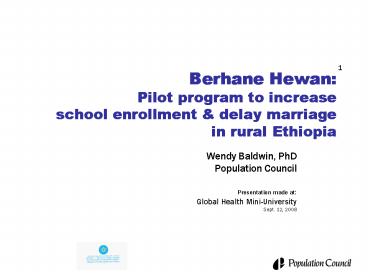Berhane Hewan: Pilot program to increase school enrollment - PowerPoint PPT Presentation
1 / 22
Title:
Berhane Hewan: Pilot program to increase school enrollment
Description:
Percentage of Ethiopian girls who are married by age 15 and age 18, among those ... age at first sex and birth among Ethiopian girls aged 15 to 24, by marital ... – PowerPoint PPT presentation
Number of Views:58
Avg rating:3.0/5.0
Title: Berhane Hewan: Pilot program to increase school enrollment
1
Berhane Hewan Pilot program to increase school
enrollment delay marriage in rural Ethiopia
- Wendy Baldwin, PhD
- Population Council
- Presentation made at
- Global Health Mini-University
- Sept. 12, 2008
2
Percentage of Ethiopian girls who are married by
age 15 and age 18, among those aged 15 to 24, by
region
Based on survival analysis to account for
censored cases Source PC tabulations of EDHS
Individual survey (2005)
3
Median age at first sex and birth among Ethiopian
girls aged 15 to 24, by marital status age at
marriage
Based on survival analysis to account for
censored cases Source PC tabulations of EDHS
Individual survey (2005)
4
Berhane Hewan (Light for Eve)
- Pilot project in Mosebo Kebele Administration,
Amhara Region (second largest region in
Ethiopia) - Program of Ministry of Youth Sport Amhara
Regional State Youth Sports Bureau - Targets married and unmarried girls aged 10 to 19
- Pilot tested 2004 to 2006
5
Objectives of Berhane Hewan
- Goal To establish appropriate effective
mechanisms to protect girls at risk of forced
early marriage and support adolescent girls who
are already married. - To create safe social spaces for the most
vulnerable and isolated girls, including access
to education - To reduce the prevalence of early, child marriage
among adolescent girls and - To increase use of reproductive health services
among sexually experienced girls.
6
Three strategies used to achieve objectives
- Social mobilization and group formation by adult
female mentors - Participation in non-formal education
livelihoods training for out of school girls, or
support to remain in school, which included an
economic incentive, and - Community conversations, a technique engaging
the community, at large, in discussion on key
issues, including early marriage, and collective
problem-solving.
7
Social mobilization group formation
- Female mentors who are prominent women in the
community, with at least 10 years education, and
many with experience teaching non-formal
education (NFE) - Mentors trained for 5 days on non-formal
education, reproductive health, HIV/AIDS,
facilitation techniques - Refresher training subsequently took place
8
Social mobilization group formation (cont)
- Mentors recruit girls aged 10 to 19 through door
to door visits in their communities - Eligible girls invited to take part in program
- Permission and support sought from gatekeepers
such as parents and husbands
9
Girls groups support to remain in school
- Three options for participation
- Support to remain in/return to school
- Participation in unmarried girls groups led by
mentors - Participation in married girls groups led by
mentors.
10
Girls groups support to remain in school
(cont)
- Support to remain in/return to school
- Provision of school materials such as exercise
books, pens, and pencils - Participating girls were provided with an average
of 36 Birr or US 4 per year, in school materials
11
Girls groups support to remain in school
(cont)
- Participation in girls groups led by mentors
- Unmarried girls meet 5 times per week
- Provision of non-formal education, livelihoods
skills, reproductive health education, and
referrals
12
Building family level support for girls
participation
- At the time of registration, family support was
sought - Both girl and parents
- Girls participation was requested at 80 percent
of all meetings - Girls who participated in 80 percent of meeting
and were not married during the pilot period
received a goat (value about 180 Birr, or US 20)
13
Building community support for girls well-being
- Community conversations to discuss child marriage
and other issues effecting the well being of
girls. - All community members regardless of age, sex or
stature - Community conversations take place every two
weeks
14
Participation in the program (2004-06)
Program is now being upscaled to 10,000 girls 10
to 19
15
Evaluation of Berhane Hewan program
- Baseline survey in experimental and control sites
before program started (2004) - Endline survey in same sites after two years of
intervention (2006) - Control site allows us to measure exogenous
changes - Changes in experimental site, significantly
different from control, attributable to project
16
Extensive exposure to the intervention No
contamination in the control site
- 92 percent of girls in the experimental area had
heard of Berhane Hewan Adolescent Girls
Program - Not one girl in the control site had heard of the
program - 85 percent of experimental girls participated in
the program - 52 percent supported to remain in school
- 23 percent in group for unmarried girls
- 10 percent in married girls groups
- 73 percent of girls attended a community
conversation, mainly on early marriage or HIV/AIDS
17
Significant increases in educational
participation
Educational participation among experimental
control respondents, by time of survey and age
group
Differences between groups significant at
plt0.05 plt0.01 plt0.001
18
Changes in patterns of marriage
Marriage among experimental control groups, by
time of survey age group
Differences between groups significant at
plt0.05 plt0.01 plt0.001
19
Significant delays in marriage from early to
later adolescence
Percent of adolescent girls married at endline,
by age area of residence
20
Summary of Berhane Hewan Impact
21
Improving girls lives through effective
programming
- Berhane Hewan is one of Africas first rigorously
evaluated programs aiming to delay marriage and
increase educational participation - Program was extremely well implemented, with high
coverage - Demonstrates that significant changes in marriage
and education can be effected in relatively short
time period.
22
Project Leadership
- Annabel Eruklar, Ph.D.
- Country Director,
- Ethiopia
- aerulkar_at_popcouncil.org































